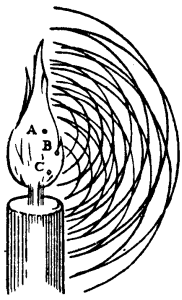Contact Forces
Table of Contents
I have then shown:
- how one may conceive Light to spread successively, by spherical waves
- how this spreading happens at a great speed as that seen in experiments and celestial observations.
The particles are in continual movement.
The successive propagation of the waves cannot be hindered by those particles because that propagation is not caused [carried] by those particles.
That wave-propagation is made up of small agitations which must communicate to those surrounding.
- This persists even if movements act on them and cause them to change positions amongst themselves.
What is the origin of these waves? How do they spread?
Each little region of a luminous body, such as the Sun, a candle, or a burning coal, generates its own waves from its center.

A flame has the points A, B, C.
- Concentric circles around each of these points represent the waves which come from them.
The same is true for every point of the surface and of the part within the flame.
But the percussions at the centres of these waves have no regular succession.
- It must not be supposed that the waves follow one another at equal distances.
If the distances marked in the shape appear to be such, it is rather to mark the progression of one-and-the-same wave at equal intervals of time than to represent several of them issuing from one and the same centre.
This prodigious quantity of waves traverse one another without confusion and without effacing one another.
This is because one-and-the-same particle of matter can serve for many waves coming from different sides or even from contrary directions.
- This can happen if it is struck by consecutive blows and instantaneous actions.
It can do so because the spreading of the movement is successive.
Huygen’s Cradle
This may be proven by the row of hard, equal spheres, spoken of above.
- Two similar spheres
AandDare pushed from 2 opposite sides at the same time as shown below. - Each sphere will rebound with the same velocity which it had after striking.
- Yet the whole row will remain in its place, even if the movement has passed along its whole length twice over.
If these contrary movements happen to meet at the middle sphere B or at C, that sphere will yield.
- It will act as a spring at both sides and simultaneously transmit these 2 movements.

It is incredible that the undulations produced by such small movements and corpuscles would spread to immense distances. An example is from the stars to us.
The force of these waves grows weaker as they move away from their origin.
- The action of each one will not be seen by us.
From a great distance, infinite waves comes from the luminous body at different points.
These unite together in such a way that they sensibly compose 1 single wave only.
- This gives it enough force to make itself felt through our eyes.
From each luminous point, there may come many thousands of waves in the smallest time. This is from the frequent percussion of the corpuscles which strike the Ether at these points.
This contributes to making their action more sensible.